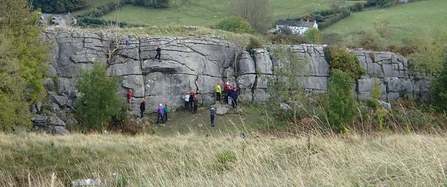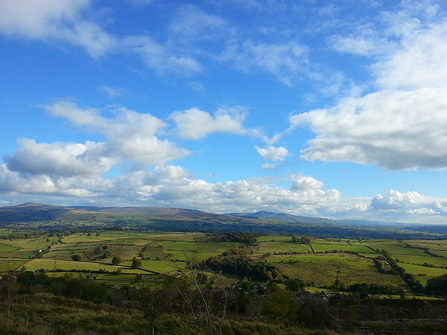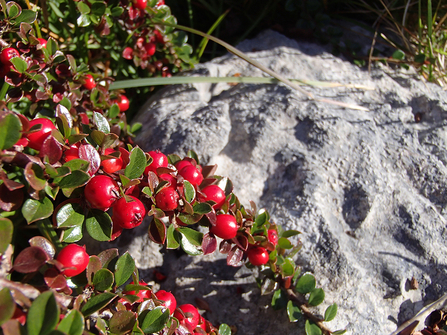Hutton Roof Crags are one of the best examples of Limestone Pavement in the UK, and yet they’re largely deserted, even on a sunny Bank Holiday Sunday. Sitting just to the east of Burton-in-Kendal their rugged grey crags loom large over the M6 and always let me know when I’m close to home. There are a few ways of getting to them, first off you could follow the sign posted road out of Burton-in-Kendal and after a couple of miles you’ll find a lovely big car park and picnic area. It’s free to park so you’ll have plenty of time to scramble around the crags. Best advice from there is to head for the trig point and work your way North West, it’s open access land but watch your footing, it’s easy to twist an ankle on the very uneven surface. Alternately you could continue up and park in the village of Hutton Roof; either way you can enjoy some interesting walks through a varied landscape.

Hutton Roof 2013. Steve Pipe
We’ve visited there twice now, the first time was back in May and the second time was last weekend and on both occasions we were blessed with wonderful sunny weather. Back in May we parked at the main car park and wound our way up through the woods where we were surprised to see someone had had a go at building shelters out of the many branches and bits and pieces from the woodland floor. There was also evidence of coppicing, which looks pretty brutal but is essential if the woodland is to be properly managed. I’ve learned a bit about woodland management from the various folks I’ve spoken to and it’s a really tricky business. Many people wonder why we have to keep interfering with the woodland when it’s “looked after itself for long enough”. But the truth is man has always looked after the woodlands, even if, back in the day, they didn’t realise quite what they were doing. Historically people grazed animals on woodland; cattle, horses, sheep, pigs etc. and these creatures naturally thinned out woodland floors and kept everything healthy. Without them things soon get overcrowded and species like Silver Brich can start to take over. The only solution is to reintroduce grazing, which isn’t always practical in more remote areas, or to follow a programme of woodland management involving coppicing.
Coppiced areas can also provide quite dramatic scenes if done properly. Occasional trees are left standing and dead wood provides an excellent habitat for insects to live in and, where there’s insects, there’s birds. I’m always fascinated to see how clinically woodpeckers can create a perfect hole in a dead tree, if only we could tame them somehow and use them as a sort of organic power drill…

Hutton Roof 2013. Steve Pipe
As you the woodland behind the landscape changes dramatically as you make your way out onto the exposed limestone pavement. It is so spectacular to look at; solid rock sculpted into beautiful and unusual shapes thanks to a large glacier or two and several thousand years of good old Cumbrian weather. There are established paths up here but they can be tricky to locate and it’s certainly not a landscape for those unsteady on their feet; kids, however, will probably love leaping from outcrop to outcrop. You really do need to watch your footing though as some of the gaps can be quite deep. As you’ll know from our Humphrey Head blog we’re very familiar with rocks and can tell you all about Limestone pavement and its many clints and grikes; the “grikes” are the deep fissures and the “clints” are the flat bits inbetween and it gets the name “pavement” because, well, it looks like a pavement – though most councils would probably get sued pretty quickly if their pavements were as uneven as these. What we know a lot less about is all the vegetation growing on top of, and deep within, the pavement.
On our most recent visit we found a suitably sunny spot for lunch with stunning views across to Ingleborough (another famous limestone outcrop); that’s the other thing about limestone pavement, plenty of nice flat spots to sit down on and enjoy your lunch. After we were done we started exploring and were stunned at the amount of different species within 10m of our picnic spot. Steve got plenty of pics as we were only familiar with a few of them - maybe you could take a look at the pictures and see if you can help us out? There was a distinct difference between those plants that were growing on top of the “clints” and those growing deep within the “grikes”. We also found one bush (unidentified) which although it wasn’t bright, flowery and colourful did seem to attract every flying insect within a 5 mile radius; we’ve added some pics of that too in case anyone can help us identify it.

Hutton Roof 2013. Steve Pipe
We kept our eyes peeled for wildlife but apart from the myriad of insects on the strange green bush there wasn’t a lot else around. We spotted a Kestrel away in the distance hovering high and looking for his lunch and were impressed with ourselves that we managed to recognise it. Well we mostly recognised it; we did double check with our RSPB bird guide just to be sure. There was also lots of evidence of rabbit activity, now I know rabbits aren’t rare, but I’ve always wondered why they all decide to, ahem, pooh, in one big pile. Is it just a spectacular coincidence or do they have designated “pooh zones”, or do I just have too much time on my hands if I’m pondering about such things?
Anyway, the time had come to make our way back through the woods to the car. As we sauntered along the path we noticed how wonderfully thick and green the moss was; a proper shagpile carpet covering most of the rocky outcrops in the woods. However hard we tried the cameras just didn’t seem to capture it properly. The last meadow we passed through was full of really tall dead plants. We think they may be Giant Hogweed, but we’re not entirely sure, they were certainly tall though. At 6ft 4ins Steve towers over most things but he was only just tall enough to get an overhead shot of these. They looked quite dramatic in the afternoon sun, all dried out and creating an almost ethereal feel to the meadow. A quick hop over the stile and we were back at the car, replete, relaxed and ready to nip down to the Kent Estuary to see if we could get lucky with some starling spotting.
About the authors: Beth Pipe is an outdoor writer and blogger and Steve is a photographer. You can read more blogs about Life & Hiking in Cumbria by Steve & Beth on their Cumbrian Rambler webpage

